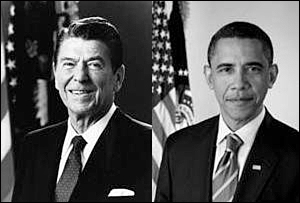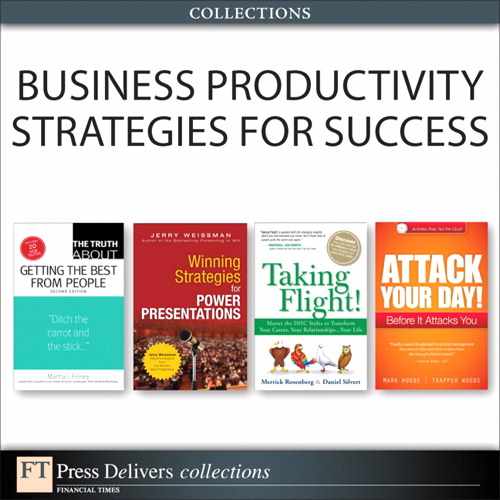29. Ronald Reagan and Barack Obama
Masters of the Game

No book on presentations would be complete without reference to two masters of the game: the 40th and 44th Presidents of the United States, Ronald Reagan and Barack Obama; two men whose politics are poles apart, but who share one common touch point that serves as a lesson for any presenter.
Although their speaking styles also differ—Mr. Reagan, the genial former actor from the Midwest, who overwhelmed audiences with his underplaying, and Mr. Obama, the cool former Ivy League attorney, who rouses audiences with his dynamic voice and elegant bearing—both men use their individual styles in the service of their outstanding ability to tell human interest stories.
Mr. Reagan almost singlehandedly invented the anecdotal game. The Great Communicator rarely missed an opportunity to tell a tale about a brave soldier or a dedicated student. Readers of Presentations in Action will recall the story of how, in 1983, Mr. Reagan honored the courageous act of a federal employee named Lenny Skutnik by recounting the details of the act during the State of the Union Address—while Mr. Skutnik sat next to Nancy Reagan—establishing a precedent that every president since has followed.
Mr. Obama appreciates Mr. Reagan’s talents. In his autobiography, The Audacity of Hope, Mr. Obama frequently referenced his predecessor. “I understand his appeal,” Mr. Obama wrote, referring to Mr. Reagan’s ability to spark Americans to “rediscover the traditional virtues of hard work, patriotism, personal responsibility, optimism and faith. That Reagan’s message found such a receptive audience spoke...to his skills as a communicator.”1
Mr. Obama took his appreciation of Mr. Reagan along with him during his 2010 holiday vacation in Hawaii in the form of a book. At holidays, which are usually slow news periods, media interest sometimes turns to what the president is reading.2 That year it was a biography called President Reagan by Lou Cannon. In it, Mr. Obama read a statement Mr. Reagan made just after he left office:
Some of my critics over the years have said that I became president because I was an actor who knew how to give a good speech. I suppose that’s not too far wrong. Because an actor knows two important things—to be honest in what he’s doing and to be in touch with the audience. That’s not bad advice for a politician either. My actor’s instincts simply told me to speak the truth as I saw it and felt it.3
Little did Barack Obama know how meaningful that statement would be. Shortly after his return from that vacation, on January 8, 2011, a deranged Jared Lee Loughner shot Representative Gabrielle Giffords and 18 other people during a public citizens’ meeting held in a supermarket parking lot in Tucson, Arizona. Four days after that tragic event, Mr. Obama flew to Tucson to address a stunned nation and the families and friends of the victims at a memorial service at the University of Arizona.
After a very brief formal opening of condolences including a passage from Scripture, Mr. Obama began to talk about each of the victims. In simple, but eloquent words, he painted a warm human picture of each person’s life—especially that of nine-year-old Christina Taylor Green whose story he extended as a role model for the nation:
Imagine—imagine for a moment, here was a young girl who was just becoming aware of our democracy; just beginning to understand the obligations of citizenship; just starting to glimpse the fact that some day she, too, might play a part in shaping her nation’s future. She had been elected to her student council. She saw public service as something exciting and hopeful. She was off to meet her Congresswoman, someone she was sure was good and important and might be a role model. She saw all this through the eyes of a child, undimmed by the cynicism or vitriol that we adults all too often just take for granted.
I want to live up to her expectations.4
The passage could have been taken right out of the Ronald Reagan style manual.
Validation came from the Wall Street Journal’s Peggy Noonan, a former speechwriter for Mr. Reagan and a frequent critic of Mr. Obama. In her postmortem of the Tucson event, she wrote, “About a third of the way through, the speech took on real meaning and momentum, and by the end it was very good, maybe great.” She attributed the pivot to “when Mr. Obama started to make things concrete...specific facts about real human beings.”5
“Specific facts about real human beings,” is sound advice for any speaker.
